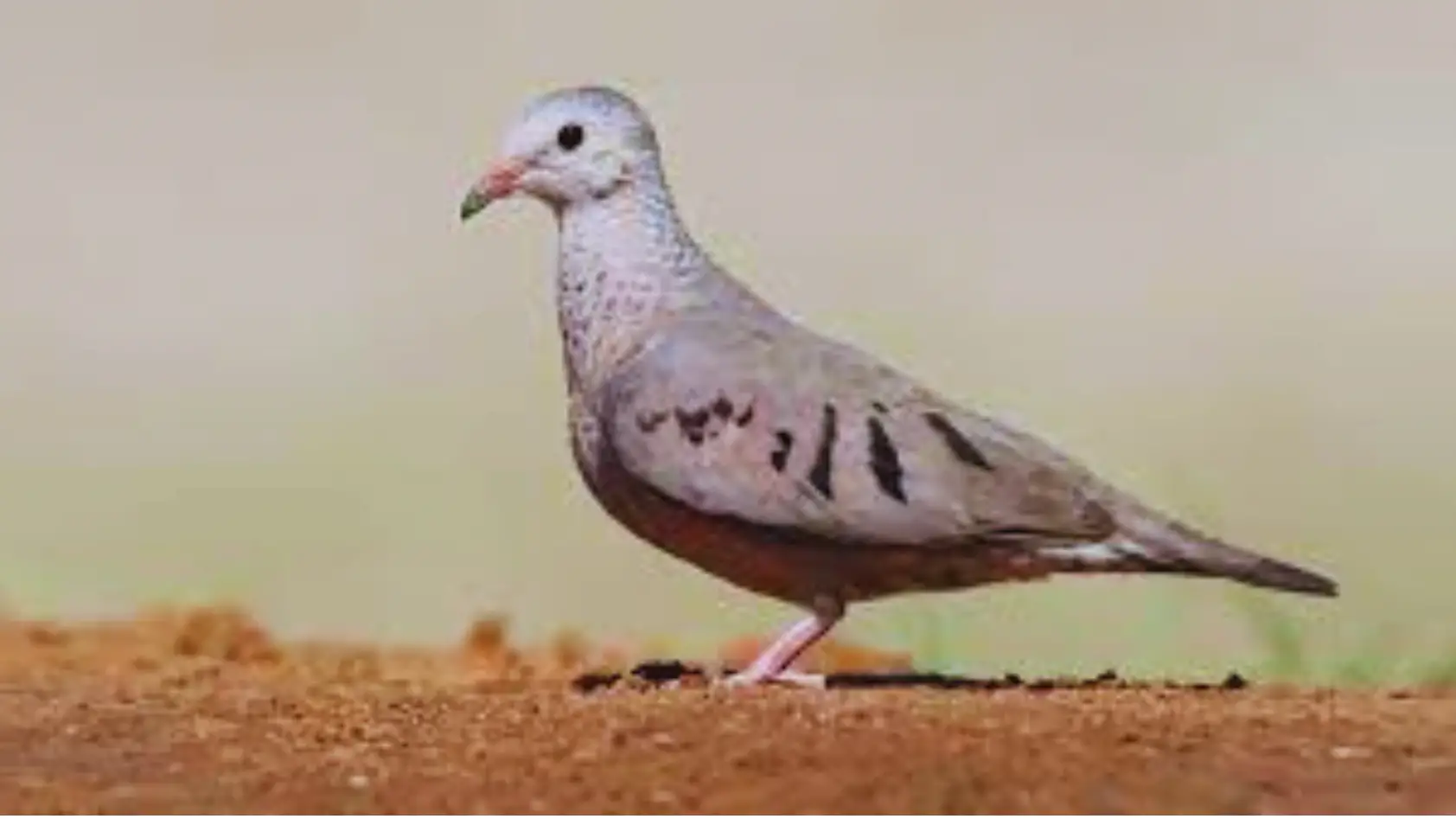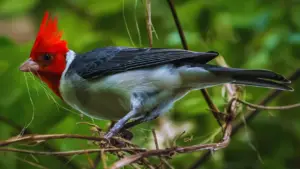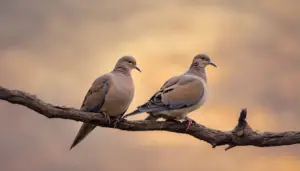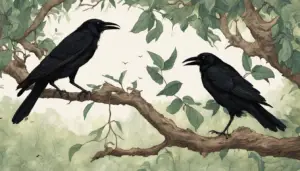Are you ready to embark on a journey of awe and tranquility? Get ready to discover the enchanting world of doves birds, these remarkable creatures that grace our skies with their gentle presence.
Doves, the epitome of peace and harmony, have captivated hearts and minds throughout history. From ancient cultures to modern societies, their symbolism as icons of peace is unparalleled.
In this article, we will delve into the captivating behavior and characteristics of doves birds, explore the different species that inhabit our planet, and unravel the melodious coos and sounds that serenade our days.
But it doesn’t stop there. Doves birds play a crucial role in maintaining ecological balance, and their significance in art, literature, and mythology is simply breathtaking. Moreover, these gentle avians have even found their place as therapy animals, bringing comfort and solace to those in need.
So join us in celebrating the peaceful presence of these magnificent creatures, as we delve into their world of grace, beauty, and serenity.
Key Takeaways
- Doves have been widely recognized as symbols of peace and harmony throughout history.
- Doves play a significant role in art, literature, and mythology, often representing peace and tranquility.
- Doves have therapeutic qualities and are used as therapy animals to reduce anxiety and stress.
- Conservation efforts are crucial for preserving dove populations, including habitat preservation and anti-poaching measures.
Historical Significance of Doves in Different Cultures
Let’s explore the captivating historical significance of doves birds in various cultures!
Throughout history, doves have held a special place in the hearts and minds of people worldwide. They have symbolized love, peace, and purity in numerous societies.
In ancient Greece, doves birds were associated with Aphrodite, the goddess of love and beauty. These birds were considered sacred to her and often depicted in artwork alongside her. Similarly, the Romans also regarded doves as symbols of love and devotion, linking them to the goddess Venus.
Christian tradition often associates doves with the Holy Spirit. In the biblical story of Noah’s Ark, a dove brings an olive branch back to the ark, symbolizing the end of the flood and the restoration of peace. This image has become a powerful emblem of hope and peace within Christianity.
Native American cultures view doves birds as messengers of peace. They believe encountering a dove brings good news and blessings. Additionally, doves are seen as symbols of harmony and balance in many indigenous communities.
From ancient times to the present day, doves birds have played a significant role in cultures worldwide. Their peaceful presence and gentle nature continue to inspire and uplift humanity, reminding us of the importance of love, peace, and harmony.
Symbolism of Doves as Icons of Peace
Revered for their serene nature, doves have long been regarded as powerful symbols of harmony and tranquility. These gentle birds have become icons of peace in many cultures and have played a significant role in promoting peaceful messages throughout history.
The symbolism of doves as icons of peace can be traced back to ancient civilizations. In Greek mythology, doves were associated with Aphrodite, the goddess of love and peace. The dove was believed to bring messages of peace and reconciliation. Similarly, in Christian iconography, the dove represents the Holy Spirit and is a symbol of peace and purity.
The dove’s association with peace is also deeply rooted in historical events. One of the most well-known instances is the story of Noah’s Ark, where a dove was sent out to find land after the Great Flood. When the dove returned with an olive branch, it symbolized the end of the destruction and the beginning of a new era of peace.
Today, the dove remains a powerful symbol of peace and is often used in various forms of art and literature to convey messages of harmony and unity. It serves as a reminder of the importance of peaceful coexistence and the need to resolve conflicts through peaceful means.
In conclusion, doves birds have become enduring symbols of peace due to their serene nature and historical significance. Their presence continues to inspire individuals and communities to strive for harmony and tranquility in a world that often faces turmoil and unrest.
Behavior and Characteristics of Doves

The behavior and characteristics of doves can be observed through their graceful flight and gentle cooing. These peaceful birds have a distinct way of moving through the air, their wings gliding effortlessly as they soar above. Their flight is a reflection of their peaceful nature, a symbol of serenity and tranquility.
As you watch doves birds in flight, you can’t help but feel a sense of calm wash over you. Their graceful movements evoke a feeling of freedom and lightness, as if they are floating on a gentle breeze. It’s as if they are reminding us to let go of our worries and embrace the beauty of the present moment.
And then there’s their gentle cooing, a soft and soothing sound that can instantly put your mind at ease. It’s a melody that speaks of comfort and peace, a reminder that in the midst of chaos, there is always a place for serenity.
In the presence of doves birds, you can’t help but be moved by their symbolism. They represent hope, love, and the power of peace. Their behavior and characteristics serve as a reminder of the importance of finding inner peace and spreading it to others.
So, let the gentle flight and cooing of doves inspire you to embrace peace in your own life and share it with the world.
The Different Species of Doves
Imagine yourself surrounded by a diverse array of dove species, each one captivating in its own unique way. These gentle avians come in various sizes and colors, adding beauty and tranquility to any environment.
One of the most common species is the Mourning Dove, known for its soft cooing sound and delicate appearance. With its slender body and long tail, it gracefully glides through the air, captivating onlookers with its elegance.
Another notable species is the Diamond Dove, which features a striking pattern of black and white spots on its wings and back. These small doves birds are known for their playful nature and are often kept as pets.
If you look closely, you might spot a White-winged Dove, distinguished by its white wing patches and a distinct call that sounds like a mournful whistle. It is larger than other dove species and can be found in various habitats.
Lastly, the Spotted Dove, with its tan and gray plumage adorned with black spots, adds a touch of charm to its surroundings. These doves are known for their gentle demeanor and can be found in urban areas as well as woodlands.
Each species of dove brings its own unique charm and adds to the peaceful presence of these birds. Embrace their beauty and enjoy the tranquility they bring.
Doves’ Beautiful Coos and Sounds
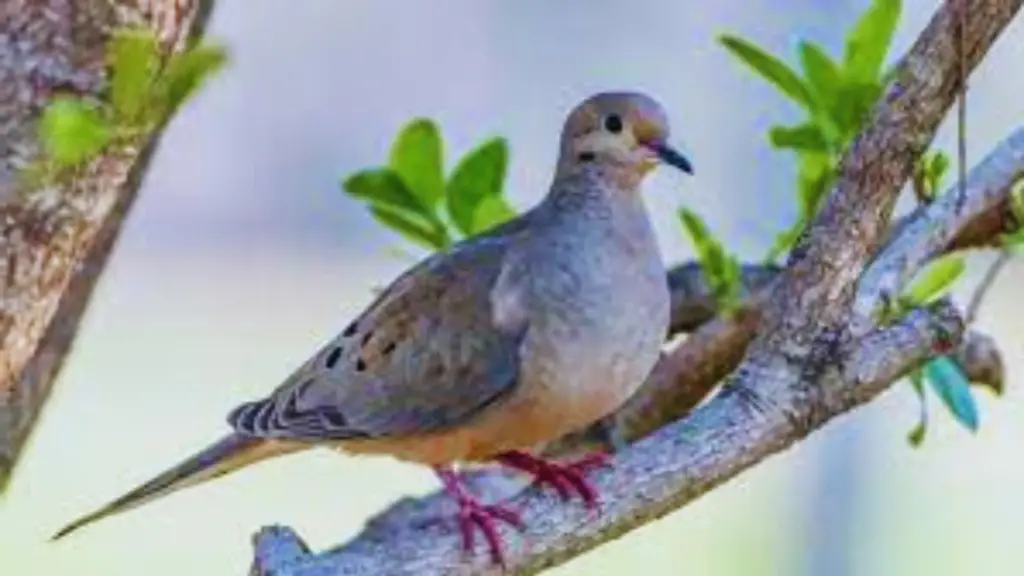
You’ll be amazed at the enchanting melodies that fill the air as doves serenade you with their melodious coos, like a symphony of joy and tranquility. The beautiful coos and sounds of doves birds are truly a treat for the senses. It’s as if they have the ability to bring peace and calm to any space they inhabit. Their coos are soft and gentle, like a lullaby that soothes the soul.
When you hear a dove cooing, it’s hard not to stop and listen. The sound is so distinct and melodic, it’s almost as if they are singing just for you. Their coos can vary in length and pitch, creating a mesmerizing harmony that captivates all who hear it. It’s a sound that instantly puts you at ease, washing away any stress or worries you may have.
Doves are known for their monogamous nature, and their coos are often a way for them to communicate with their mates. It’s their way of saying ‘I love you’ and reaffirming their bond. Their coos can also serve as a territorial call, marking their space and letting other doves birds know that they are present.
So the next time you find yourself in the presence of doves, take a moment to appreciate their beautiful coos and sounds. Let yourself be transported to a place of tranquility and peace as their melodies fill the air. It’s a truly magical experience that will leave you feeling uplifted and inspired.
Doves’ Graceful Flight and Movement
Witness the mesmerizing grace and fluidity of doves as they effortlessly glide through the air, their movements a ballet of elegance and beauty. It is truly a sight to behold as these gentle avians soar through the sky with such poise and finesse. With their long and slender wings, doves gracefully navigate the air currents, their flight appearing almost effortless. They move with a sense of purpose, their feathers glistening in the sunlight, creating a mesmerizing display of iridescent colors.
As you watch these magnificent birds in flight, you can’t help but be captivated by their agility and precision. They twist and turn, their bodies adjusting effortlessly to maintain their balance and control. With each beat of their wings, they propel themselves forward, gliding through the air with a sense of freedom and tranquility.
To truly appreciate the beauty of doves’ flight, take a moment to imagine yourself soaring alongside them. Picture the feeling of the wind against your face, the sensation of weightlessness as you effortlessly glide through the sky. Close your eyes and let your imagination take flight, as you become one with these graceful creatures.
Now, take a look at the table below to discover the deeper meaning behind the doves’ flight and movement:
| Symbol | Meaning |
|---|---|
| Grace | Elegance and beauty |
| Freedom | Peace and tranquility |
| Harmony | Balance and unity |
| Spirituality | Connection to the divine |
Witnessing the flight and movement of doves is a reminder of the beauty and peace that can be found in the world. It serves as a gentle reminder to embrace grace, seek freedom, strive for harmony, and nurture our spirituality. So, the next time you see a dove in flight, take a moment to appreciate their graceful presence and the deeper meaning they bring to our lives.
Doves’ Nesting and Mating Habits
As you delve into the fascinating world of doves birds, you’ll discover their intricate nesting and mating habits, a captivating display of nature’s ingenuity and devotion. Doves birds are known for their commitment to their partners and their nests. Here are some interesting facts about their nesting and mating habits:
- Nest building: Doves are meticulous builders, crafting their nests with precision and care. They use twigs, grass, and leaves to create a sturdy foundation. The male dove brings the materials while the female constructs the nest, a true partnership in action.
- Monogamy: Doves are monogamous creatures, forming strong pair bonds that last a lifetime. Once they find their partner, they stick together through thick and thin, sharing the responsibilities of raising their young.
- Courtship rituals: Doves have elaborate courtship rituals that involve beautiful displays of affection. They engage in synchronized flights, where they soar and glide together, showcasing their unity and love. They also engage in soft cooing, a gentle and soothing sound that signifies their affection for one another.
These nesting and mating habits highlight the commitment and devotion that doves possess. It’s truly remarkable to witness their dedication to their partners and their nests.
So next time you spot a dove, take a moment to appreciate the intricate world of their nesting and mating habits, a testament to the beauty of nature.
Doves’ Role in Ecological Balance
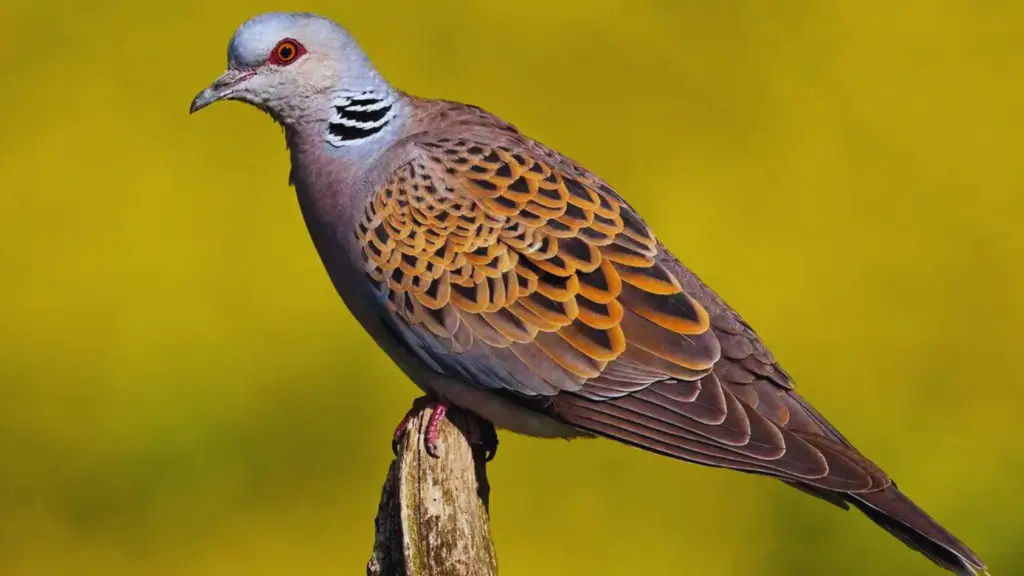
Now that you know about doves’ nesting and mating habits, let’s dive into another fascinating aspect of these beautiful birds: their role in ecological balance.
You may not realize it, but doves birds play a crucial part in maintaining the harmony of our environment.
Doves are seed eaters, and their diet primarily consists of fruits, grains, and seeds. As they flutter from tree to tree, they inadvertently aid in seed dispersal. By consuming these seeds, doves create room for new plants to grow and flourish. This process ensures the regeneration of forests and supports biodiversity.
Moreover, doves birds contribute to pollination. As they visit flowers in search of nectar, they inadvertently transfer pollen from one flower to another. This helps in the fertilization process and promotes the growth of various plant species, including those that are vital for other wildlife.
In addition to their ecological contributions, the gentle cooing of doves adds a serene soundtrack to our surroundings. Their peaceful presence and harmonious calls have a calming effect, reminding us to appreciate the simple joys of nature.
So, next time you spot a dove perched on a tree branch or hear its soothing coo, take a moment to acknowledge the significant role these birds play in maintaining our ecological balance. They truly are nature’s little helpers.
Doves in Art, Literature, and Mythology
Immersed in the realms of art, literature, and mythology, doves have captivated your imagination for centuries. These graceful birds have been featured in countless paintings, poems, and stories, symbolizing peace, love, and purity.
In art, doves birds are often depicted in serene and tranquil settings, their soft white feathers and gentle demeanor evoking a sense of calmness. Artists use their delicate form to convey a sense of tranquility and harmony in their works. From Renaissance paintings to modern sculptures, doves continue to inspire and uplift the human spirit.
Literature also embraces the symbolism of doves. In various poems and novels, these birds are often associated with love and affection. They are seen as messengers of hope and reconciliation, bringing people together in times of conflict and turmoil. Their presence in literature serves as a reminder of the power of love and the potential for peace.
Furthermore, doves hold a significant place in mythology. In ancient Greek and Roman mythology, doves were associated with the goddesses of love and beauty, Aphrodite and Venus. These birds were seen as symbols of divine love and fertility, representing the harmonious balance between nature and humanity.
In conclusion, doves birds have left an indelible mark on the world of art, literature, and mythology. Their gentle presence continues to inspire and remind us of the importance of peace, love, and unity in our lives. So next time you encounter a dove, take a moment to appreciate the beauty and symbolism that they represent.
Doves as Therapy Animals
Doves have also found their place as therapy animals, bringing comfort and solace to those in need. These gentle birds have a calming presence and their soft coos can bring a sense of tranquility to anyone struggling with anxiety or stress. The use of doves birds in therapy is not a new concept; in fact, it dates back to ancient times when they were believed to possess healing powers.
Dove therapy involves the interaction between humans and these beautiful creatures. The simple act of watching them fly gracefully or feeling their soft feathers against your skin can have a profound effect on your emotional well-being. Doves birds are known for their ability to connect with humans on a deep level, providing a sense of companionship and unconditional love.
To truly understand the impact of doves as therapy animals, imagine sitting in a peaceful garden surrounded by these gentle birds. The table below illustrates the emotions that may arise during such an experience:
| Emotion | Description | Example |
|---|---|---|
| Peace | A state of calm and tranquility | Watching the doves fly gracefully |
| Comfort | A feeling of reassurance and relaxation | Feeling the soft feathers against your skin |
| Joy | A sense of happiness and contentment | Seeing the doves playfully interact with each other |
Doves have the power to heal and uplift the human spirit, making them invaluable therapy animals for those seeking solace and emotional support.
Conservation Efforts for Doves
Preserving the population of these beautiful creatures is a top priority for conservationists around the world. Doves, with their peaceful presence and gentle nature, play an important role in our ecosystem. Here are four ways conservation efforts are being made to protect these birds:
- Habitat preservation: Creating and maintaining suitable habitats for doves is crucial for their survival. Conservationists work to protect and restore the natural habitats where doves thrive, ensuring they have access to food, water, and nesting sites.
- Anti-poaching measures: Illegal hunting and trade pose a significant threat to dove populations. Conservation organizations collaborate with law enforcement agencies to enforce strict anti-poaching laws and crack down on illegal trade networks, aiming to prevent further harm to these birds.
- Public awareness campaigns: Educating the public about the importance of doves birds and their conservation is essential. Through outreach programs, workshops, and social media campaigns, conservationists strive to raise awareness about the threats doves face and inspire action to protect them.
- Research and monitoring: Conservation efforts rely on scientific research and monitoring to better understand dove populations and their behavior. By studying their breeding patterns, migration routes, and overall population trends, scientists can develop effective conservation strategies.
Preserving these gentle avians is not only crucial for their own well-being but also for the balance and beauty of our natural world. Together, we can ensure a future where these peaceful birds continue to grace our skies.
Doves Birds Frequently Asked Questions

What is the average lifespan of a dove?
On average, a dove’s lifespan is around 5-15 years. For example, imagine having a dove named Charlie who lived for 12 years, bringing joy and peacefulness to your backyard every day.
Can doves be trained to perform tricks or tasks?
Yes, doves birds can be trained to perform tricks or tasks. With patience and positive reinforcement, you can teach them to do things like fly to your hand, retrieve objects, or even play basketball.
How do doves communicate with each other?
“Doves communicate with each other through a variety of coos, chirps, and body movements. It’s fascinating to observe their gentle interactions, reminding us that sometimes, silence speaks louder than words.”
What is the significance of doves in Native American cultures?
The significance of doves in Native American cultures is immense. They represent peace, love, and harmony. Doves are often seen as messengers of the spirits and are deeply respected for their gentle and calming presence.
Are there any superstitions or beliefs associated with doves in different cultures?
In different cultures, there are several superstitions and beliefs associated with doves. For example, in Greek mythology, doves birds were considered sacred to the goddess Aphrodite, representing love and beauty.
Conclusion
As you reflect on the peaceful presence of doves, you can’t help but appreciate the historical significance and symbolism they hold across cultures.
Their gentle behavior and beautiful coos create a sense of tranquility.
Doves also play a vital role in maintaining ecological balance, reminding us of their importance in the natural world.
From art to therapy, these birds have touched our lives in various ways.
As we celebrate doves, let us also remember the need for conservation efforts to protect these magnificent creatures.

